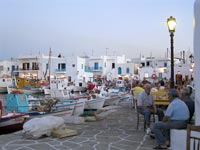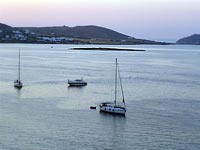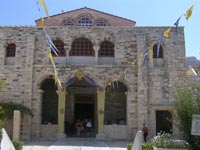 PAROS VILLAGES & HISTORY OF PAROS ISLAND GREECE
PAROS VILLAGES & HISTORY OF PAROS ISLAND GREECE
Paros Villages
Naoussa Village, Paros:

Naoussa is the most scenic of all Paros villages. It is a spellbinding town with a quaint fishing port, traditional white-washed houses, small seaside cafes, fish taverns, bars and clubs in its narrow winding alleyways, always packed with people. Naoussa is a perfect vacation destination that offers a wide range of hotels, apartments, rooms for rent and studios, most of which have a spectacular view of Naoussa Bay and the deep blue Aegean waters. In Naoussa, there are several historic sites such as the Venetian Castle in the port, the Mycenaean Acropolis near Kolimbithres Beach and the Monastery of Agios Athanasios. In and around Naoussa are the beautiful beaches of Santa Maria, Kolimbithres, Monastiri and Lageri, where visitors can spend hours relaxing beneath the warm sun.
Marpissa Village, Paros:
The village of Marpissa is a traditional settlement resting on a hillside. It is located just a few kilometers from the beaches of Logaras and Piso Livadi. The village is built around the Cathedral of the Metamorfosi and is at close proximity to historical monuments on Kefalos Hill, including the wonderful Monastery of Agios Antonios.
Piso Livadi Village, Paros:
 Piso Livadi is one of the most attractive Paros villages and is the ideal spot for peaceful holidays. It has a small fishing port, which is a charming place for a stroll, and an abundance of hotels, apartments and rooms to let. Piso Livadi Beach is quite impressive, with golden sand and tamarisk trees. The nearby beaches of Chryssi Akti and Nea Chryssi Akti are favorites of windsurfers. Piso Livadi is one of the most attractive Paros villages and is the ideal spot for peaceful holidays. It has a small fishing port, which is a charming place for a stroll, and an abundance of hotels, apartments and rooms to let. Piso Livadi Beach is quite impressive, with golden sand and tamarisk trees. The nearby beaches of Chryssi Akti and Nea Chryssi Akti are favorites of windsurfers.
Lefkes Village, Paros:
Lefkes is a beautiful village built on a verdant hill with pine, almond and elm trees. It is the most traditional of all Paros villages, with Cycladic styled and neoclassical buildings, marble streets and quaint squares. Lefkes is located at the highest point of Paros and offers a breathtaking view. In Lefkes, you can visit the marble Church of Agia Triada and the Monastery of Agios Ioannis Kaparos.
Kostos Village, Paros:
Kostos is an impressive island village with narrow alleyways, a lovely square and beautiful green pines. Kostos village was used in antiquity as an outpost, because of its panoramic view of the island. Today, this view is enjoyed by hundreds of vacationers.
Archilochos, Paros - Marmara Village & Prodromos Village:
The area of Archilochos is comprised of the two small villages Marmara and Prodromos.
Marmara village is named after the marble that was used to build the old mansions and Byzantine churches in the village - the most noteworthy being Agios Savvas. Near Marmara are the beaches of Molos and Kalogeras.
The village of Prodromos can be entered by passing under an arch-shaped roof which connects the two small churches of Agios Spyridon and Agios Nikolaos. A stone-paved path, built during the Byzantine Era, on the northwestern side of the village, leads up to Lefkes village.
Paros History:
 The history of Paros Island started as far back as the Stone Age, although very little is known before the 2 nd millennia BC, when the Minoans settled on the island. The name Paros comes from Parios, the son of Parassios of Arcadia, who colonized the island in the 1 st millennium BC. The history of Paros Island started as far back as the Stone Age, although very little is known before the 2 nd millennia BC, when the Minoans settled on the island. The name Paros comes from Parios, the son of Parassios of Arcadia, who colonized the island in the 1 st millennium BC.
Paros was the birthplace of many enlightened scholars, such as the great poet Archilochos - who during his lifetime, was considered to be as important as Homer - and the famous sculptors Scopas and Agoracritos, who carved wonderful works of art from the renowned Parian marble.
During the Byzantine Era, splendid monasteries and churches were erected on Paros, including the impressive Church of Panagia Ekatontapyliani (Our Lady of a Hundred Gates), the jewel of the island. Later, Paros was overrun by pirates and many people left the island to seek their fortunes elsewhere. Venetian Rule had a significant effect on Paros, as can be seen from the Venetian Castles and buildings scattered throughout the villages. After the Greek Revolution in 1821, Paros was incorporated into the New Greek Republic. Today, Paros is an extremely popular holiday destination for vacationers from Greece and abroad.
|
|

 Piso Livadi is one of the most attractive Paros villages and is the ideal spot for peaceful holidays. It has a small fishing port, which is a charming place for a stroll, and an abundance of hotels, apartments and rooms to let. Piso Livadi Beach is quite impressive, with golden sand and tamarisk trees. The nearby beaches of Chryssi Akti and Nea Chryssi Akti are favorites of windsurfers.
Piso Livadi is one of the most attractive Paros villages and is the ideal spot for peaceful holidays. It has a small fishing port, which is a charming place for a stroll, and an abundance of hotels, apartments and rooms to let. Piso Livadi Beach is quite impressive, with golden sand and tamarisk trees. The nearby beaches of Chryssi Akti and Nea Chryssi Akti are favorites of windsurfers.  The history of Paros Island started as far back as the Stone Age, although very little is known before the 2 nd millennia BC, when the Minoans settled on the island. The name Paros comes from Parios, the son of Parassios of Arcadia, who colonized the island in the 1 st millennium BC.
The history of Paros Island started as far back as the Stone Age, although very little is known before the 2 nd millennia BC, when the Minoans settled on the island. The name Paros comes from Parios, the son of Parassios of Arcadia, who colonized the island in the 1 st millennium BC.